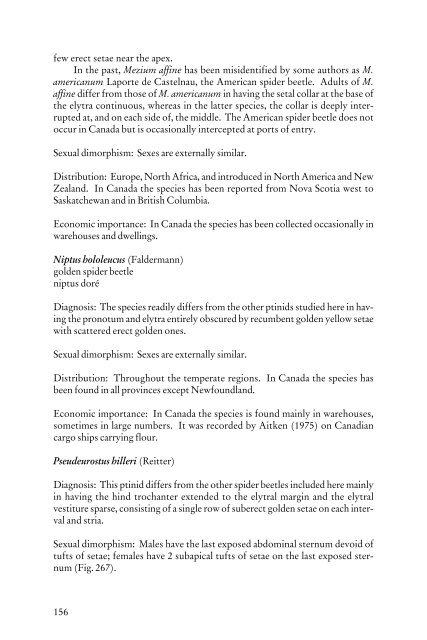Beetles Identification Guide
Beetles Identification Guide
Beetles Identification Guide
Create successful ePaper yourself
Turn your PDF publications into a flip-book with our unique Google optimized e-Paper software.
few erect setae near the apex.<br />
In the past, Mezium affine has been misidentified by some authors as M.<br />
americanum Laporte de Castelnau, the American spider beetle. Adults of M.<br />
affine differ from those of M. americanum in having the setal collar at the base of<br />
the elytra continuous, whereas in the latter species, the collar is deeply interrupted<br />
at, and on each side of, the middle. The American spider beetle does not<br />
occur in Canada but is occasionally intercepted at ports of entry.<br />
Sexual dimorphism: Sexes are externally similar.<br />
Distribution: Europe, North Africa, and introduced in North America and New<br />
Zealand. In Canada the species has been reported from Nova Scotia west to<br />
Saskatchewan and in British Columbia.<br />
Economic importance: In Canada the species has been collected occasionally in<br />
warehouses and dwellings.<br />
Niptus hololeucus (Faldermann)<br />
golden spider beetle<br />
niptus doré<br />
Diagnosis: The species readily differs from the other ptinids studied here in having<br />
the pronotum and elytra entirely obscured by recumbent golden yellow setae<br />
with scattered erect golden ones.<br />
Sexual dimorphism: Sexes are externally similar.<br />
Distribution: Throughout the temperate regions. In Canada the species has<br />
been found in all provinces except Newfoundland.<br />
Economic importance: In Canada the species is found mainly in warehouses,<br />
sometimes in large numbers. It was recorded by Aitken (1975) on Canadian<br />
cargo ships carrying flour.<br />
Pseudeurostus hilleri (Reitter)<br />
Diagnosis: This ptinid differs from the other spider beetles included here mainly<br />
in having the hind trochanter extended to the elytral margin and the elytral<br />
vestiture sparse, consisting of a single row of suberect golden setae on each interval<br />
and stria.<br />
Sexual dimorphism: Males have the last exposed abdominal sternum devoid of<br />
tufts of setae; females have 2 subapical tufts of setae on the last exposed sternum<br />
(Fig. 267).<br />
156
















